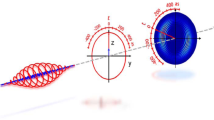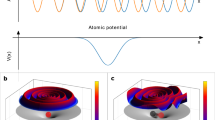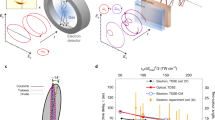Abstract
Resolving in time the dynamics of light absorption by atoms and molecules, and the electronic rearrangement this induces, is among the most challenging goals of attosecond spectroscopy. The attoclock is an elegant approach to this problem, which encodes ionization times in the strong-field regime. However, the accurate reconstruction of these times from experimental data presents a formidable theoretical task. Here, we solve this problem by combining analytical theory with ab initio numerical simulations. We apply our theory to numerical attoclock experiments on the hydrogen atom to extract ionization time delays and analyse their nature. Strong-field ionization is often viewed as optical tunnelling through the barrier created by the field and the core potential. We show that, in the hydrogen atom, optical tunnelling is instantaneous. We also show how calibrating the attoclock using the hydrogen atom opens the way to identifying possible delays associated with multielectron dynamics during strong-field ionization.
This is a preview of subscription content, access via your institution
Access options
Subscribe to this journal
Receive 12 print issues and online access
$209.00 per year
only $17.42 per issue
Buy this article
- Purchase on Springer Link
- Instant access to full article PDF
Prices may be subject to local taxes which are calculated during checkout





Similar content being viewed by others
References
Schultze, M. et al. Delay in photoemission. Science 328, 1658–1662 (2010).
Shafir, D. et al. Resolving the time when an electron exits a tunnelling barrier. Nature 485, 343–346 (2012).
Goulielmakis, E. et al. Real-time observation of valence electron motion. Nature 466, 700–702 (2010).
Eckle, P. et al. Attosecond ionization and tunneling delay time measurements in helium. Science 322, 1525–1529 (2008).
Eckle, P. et al. Attosecond angular streaking. Nature Phys. 4, 565–570 (2008).
Pfeiffer, A. N. et al. Breakdown of the independent electron approximation in sequential double ionization. New J. Phys. 13, 093008 (2011).
Pfeiffer, A. P. et al. Attoclock reveals natural coordinates of the laser-induced tunnelling current flow in atoms. Nature Phys. 8, 76–80 (2012).
Breidbach, J. & Cederbaum, L. S. Universal attosecond response to the removal of an electron. Phys. Rev. Lett. 94, 033901 (2005).
Sukiasyan, S., Ishikawa, K. L. & Ivanov, M. Attosecond cascades and time delays in one-electron photoionization. Phys. Rev. A 86, 033423 (2012).
Kheifets, A. S. & Ivanov, I. A. Delay in atomic photoionization. Phys. Rev. Lett. 105, 233002 (2010).
Moore, L. R., Lysaght, M. A., Parker, J. S., van der Hart, H. W. & Taylor, K. T. Time delay between photoemission from the 2p and 2s subshells of neon. Phys. Rev. A 84, 061404 (2011).
Klunder, K. et al. Probing single-photon ionization on the attosecond time scale. Phys. Rev. Lett. 106, 143002 (2011).
Ivanov, M. & Smirnova, O. How accurate is the attosecond streak camera? Phys. Rev. Lett. 107, 213605 (2011).
Pazourek, R., Nagele, S. & Burgdorfer, J. Time-resolved photoemission on the attosecond scale: Opportunities and challenges. Faraday Discuss. 163, 353–376 (2013).
Dahlström, J. M., L’Huillier, A. & Maquet, A. Introduction to attosecond delays in photoionization. J. Phys. B 45, 183001 (2012).
Ivanov, I. & Kheifets, A. Strong-field ionization of He by elliptically polarized light in attoclock configuration. Phys. Rev. A 89, 021402 (2014).
Boge, R. et al. Probing nonadiabatic effects in strong-field tunnel ionization. Phys. Rev. Lett. 111, 103003 (2013).
Shvetsov-Shilovski, N. I., Dimitrovski, D. & Madsen, L. B. Ionization in elliptically polarized pulses: Multielectron polarization effects and asymmetry of photoelectron momentum distributions. Phys. Rev. A 85, 023428 (2012).
Torlina, L. & Smirnova, O. Time-dependent analytical R-matrix approach for strong-field dynamics. I. One-electron systems. Phys. Rev. A 86, 043408 (2012).
Torlina, L. et al. Time-dependent analytical R-matrix approach for strong-field dynamics. II. Many-electron systems. Phys. Rev. A 86, 043409 (2012).
Kaushal, J. & Smirnova, O. Nonadiabatic Coulomb effects in strong-field ionization in circularly polarized laser fields. Phys. Rev. A 88, 013421 (2013).
Torlina, L., Kaushal, J. & Smirnova, O. Time-resolving electron–core dynamics during strong-field ionization in circularly polarized fields. Phys. Rev. A 88, 053403 (2013).
Muller, H. G. An efficient propagation scheme for the time-dependent Schrödinger equation in the velocity gauge. Laser Phys. 9, 138–148 (1999).
Tao, L. & Scrinzi, A. Photo-electron momentum spectra from minimal volumes: The time-dependent surface flux method. New J. Phys. 14, 013021 (2012).
Landsman, A. et al. Ultrafast resolution of tunneling delay time. Optica 1, 343–349 (2014).
Nubbemeyer, T., Gorling, K., Saenz, A., Eichmann, U. & Sandner, W. Strong-field tunneling without ionization. Phys. Rev. Lett. 101, 233001 (2008).
Kamor, A., Mauger, F., Chandre, C. & Uzer, T. How key periodic orbits drive recollisions in a circularly polarized laser field. Phys. Rev. Lett. 110, 253002 (2013).
Wang, X. & Eberly, J. H. Elliptical polarization and probability of double ionization. Phys. Rev. Lett. 105, 083001 (2010).
Carette, T., Dahlström, J. M., Argenti, L. & Lindroth, E. Multiconfigurational Hartree–Fock close-coupling ansatz: Application to the argon photoionization cross section and delays. Phys. Rev. A 87, 023420 (2013).
Kheifets, A. S. Time delay in valence shell photoionization of noble gas atoms. Phys. Rev. A 87, 063404 (2013).
Scrinzi, A. t-SURFF: Fully differential two-electron photo-emission spectra. New J. Phys. 14, 085008 (2012).
Sukiasyan, S. et al. Signatures of bound-state-assisted nonsequential double ionization. Phys. Rev. A 80, 013412 (2009).
Smirnova, O., Spanner, M. & Ivanov, M. Analytical solutions for strong field-driven atomic and molecular one- and two-electron continua and applications to strong-field problems. Phys. Rev. A 77, 033407 (2008).
Acknowledgements
We acknowledge stimulating discussions with U. Keller and A. Landsman. J.K., O.S. and M.I. acknowledge support of the EU Marie Curie ITN network CORINF, Grant Agreement No. 264951. F.M. and O.S. acknowledge support of the DFG project SM 292/3-1, S.S. and M.I. acknowledge support of the EPSRC Programme Grant EP/I032517/1, M.I. acknowledges the support of the United States Air Force Office of Scientific Research program No. FA9550-12-1-0482, O.S., L.T. and J.K. acknowledge support of the DFG grant SM 292/2-3. A.K. and I.I. acknowledge support of the Australian Research Council Grant DP120101805. A.Z. and A.S. acknowledge support from the DFG through excellence cluster Munich Center for Advanced Photonics (MAP) and from the Austrian Science Foundation project ViCoM (F41). O.S., M.I., F.M. and A.S. acknowledge the support of the European COST Action XLIC CM1204, H.G.M. acknowledges the hospitality of the Max Born Institute.
Author information
Authors and Affiliations
Contributions
L.T., J.K. and O.S. derived the ARM method and performed the analytical study. F.M., H.G.M., M.I., A.Z., A.S., A.K., I.I. and S.S. performed the numerical simulations and checked the convergence and consistency of the results. F.M., O.S. and M.I. analysed the origins of negative ionization times. O.S. directed and coordinated the research. L.T., M.I. and O.S. wrote the paper. All authors discussed the results and provided contributions to the text of the manuscript.
Corresponding author
Ethics declarations
Competing interests
The authors declare no competing financial interests.
Supplementary information
Supplementary Information
Supplementary Information (PDF 523 kb)
Rights and permissions
About this article
Cite this article
Torlina, L., Morales, F., Kaushal, J. et al. Interpreting attoclock measurements of tunnelling times. Nature Phys 11, 503–508 (2015). https://doi.org/10.1038/nphys3340
Received:
Accepted:
Published:
Issue Date:
DOI: https://doi.org/10.1038/nphys3340
This article is cited by
-
Tunnelling of electrons via the neighboring atom
Light: Science & Applications (2024)
-
Spatiotemporal imaging and shaping of electron wave functions using novel attoclock interferometry
Nature Communications (2024)
-
Coulomb and Quantum Interference Effects in the Spectra of High-Order Harmonics Generated by Aligned Molecules
Radiophysics and Quantum Electronics (2023)
-
Full experimental determination of tunneling time with attosecond-scale streaking method
Light: Science & Applications (2022)
-
All-optical attoclock for imaging tunnelling wavepackets
Nature Physics (2022)



